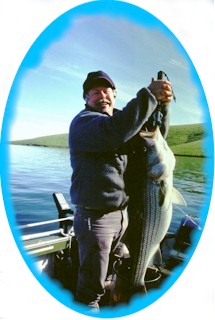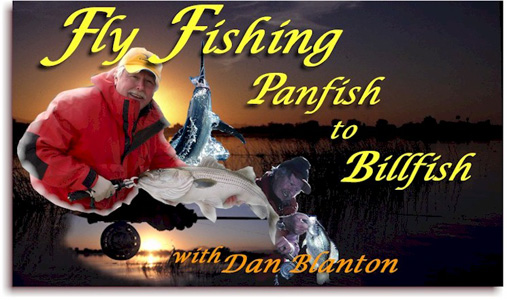
Flashtail flies markedly improve your odds both in freshwater and saltwater. The author took this 29-pound striper on a flashtail Sa-Mul-Mac from California’s San Luis Reservoir.
Increasing Your Odds With Flashtails
Written and Photographed
By Dan Blanton
You want to markedly improve your fly fishing success with striped bass, bluefish, and the tuna species? Take your old, reliable fly patterns and put a flashtail on them.
Flashtails on flies are like the tail of a comet or the flaming exhaust of a rocket heading into orbit on a black night – they are eye catchers – fish eye catchers! Around 1971 I started putting flashtails on my Standard Whistler patterns for jungle river snook. They were fashioned from mylar tinsel and while not having the action of today’s Flashabou, they profoundly improved an old, reliable standard. I never took so many snook on a fly before the addition, and my striper score soared. Today I use standard Flashabou (not the saltwater variety) for flashtails and my flies work even better, for just about any piscatorial species, particularly striped bass.
Flashtails can be fashioned from other materials, the likes of Crystal Flash, and such. However, nothing seems to work as well as Flashabou. Depending upon water clarity, your fly’s tail should include from 20 to 50 strands of material. I often mix colors, and I’m particularly fond of a 50:50 blend of pearl and silver flashabou for tails on my striper, and tuna frauds. Of course you can use less. A favorite flats tarpon pattern, a ballyhoo fake, sports a flashtail tail only containing six strands. If there is one constant, though, it’s that all of the flashtails on my bugs, protrude beyond the hair or hackle tail from a half-inch to an inch-and-a half. With Whistlers and other bucktails, the flashtail is buried between stacks of tail hair. Feather-tailed monikers, have the flashtail sandwiched between hackles, and some side flash of either Flashabou, Crystal Flash or both, can be added.
There is more going on here than just a flashing tail, however. Animation is hugely enhanced. The tail undulates and pulses as it flashes along making your pattern come alive – much more so than you can imagine. This is especially true with jig-like simulators. Just work one in clear water where you can get a good look and you’ll be absolutely convinced. Take my Whistler pattern: I often tie them with double wire snag guards. This V-shaped guard allows me to drop my fly, which is designed to sink head first, straight to the bottom and then rest there on its nose. I can’t tell you how many stripers (including largemouth bass and pike) have eaten the fly right off the bottom, convinced the thing was alive because of its flagging flashtail. Only the fish knows for sure, but I’ll give odds the fly looked like an injured baitfish struggling on the bottom. Something to think about, at any rate…
Ok, sounds good for dark or turbid water. What about in gin? Well, out west, striper water isn’t that clear, but I have fished the crystalline waters of the Cape’s Monomoy inlet and Pleasant bay and my flashtail flies scored there- big time! The beauty of using flashtail patterns is that if it happens the flash is too much or the tail too long, a pair of scissors cures all.
My Flashtail Whistlers are die-hard favorites with me, but other flashtail patterns shine, too. Take Bob Clousers great fly. It’s tied in a multiplicity of styles and each can be tied as a flashtail. One that stands head and shoulders with my Whistler is a pattern I call The SPS Flashtail Clouser. It took a 33-pound striper for me this past season. I also killed the False albacore on flashtail Alba-Clousers at North Carolina’s Cape Lookout last November. The Alberts were slamming silversides – and my flashtail Alba-Clousers.
Other great standards that wear a flashtail well? How about: Flashtail (FT) ALFs; FT Lefty’s Deceivers; FT Sar-Mul-Macs; FT Punches; FT Surf Candies; FT Crazy Charlies; FT Sea Habits; FT Abel Anchovies; Slab Sides, Catherwood Giant Killers, the list goes on…
Many of these salty monikers transcend the boundary into freshwater. The SPS (shad-perch-simulator) Flashtail Clouser tied in size 3/0 with heavy dumbbell eyes is a killer for California delta stripers. Tie it in size 2 or 4, using small lead eyes and kip tail instead of bucktail and you’ll have one of the deadliest smallmouth bass and white bass flies ever devised. Of course these mini SPS Clousers will take salt chuck stripers when the bait is tiny.
You don’t like tying fancy flies? You love fishing with simple bucktails like the time-test Joe Brooks Blonde series? Put a flashtail on these simplistic patterns and hold on to your rod!
I’ve always said that putting a flashtail on my flies for both freshwater and saltwater is my answer to a basser’s spinner bait – another deadly artificial that gets a fish’s attention. If you are a purist, you may not like this analogy, but don’t knock it until you’ve tried it. Once you do, you’ll never go back to flies without a flashtail – trust me!
Following are the tying instructions for one of my favorites, the SPS Flashtail Whistler, a deadly striper attractor, anywhere old linesides is found. Tie some up and use them with confidence of great results.
